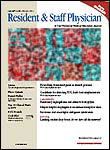Asthmatics with Elevated Eosinophil Levels Far More Likely to Require Hospital Admission
A retrospective cohort analysis showed patients with severe asthma and elevated eosinophil levels accounted for only 3% of all asthma patients but an estimated $1.3 billion in costs due to hospital admission for asthma exacerbation.
The economic burden of asthma in the United States is $56 billion each year. Using blood eosinophil levels to predict the risk of asthma exacerbation could decrease this burden substantially by targeting high-risk patients for better treatment, according to a retrospective cohort study recently published in BMC Pulmonary Medicine.
In the study, a team of U.S. researchers used a claims database to extract the records of patients age >12 years who were diagnosed with asthma between January 2004 and July 2011. The aim of the team was to determine whether healthcare resource use and costs were related to eosinophil level in patients with asthma.
On the basis of patients’ medication use during a 12-month assessment period, the researchers classified asthma as mild, moderate, or severe. They also classified patients into two groups depending on whether their eosinophil level was elevated (≥400 cells/μL) or normal (<400 cells/μL) during this period.
The researchers then assessed outcomes during a follow-up period ranging from 1 to 12 months (mean, 11 months). For each patient, follow-up included determination of resource use defined as hospital admissions, emergency department visits, and outpatient visits.
The researchers then calculated the costs associated with the consumption of these resources and used non-parametric tests to compare the two eosinophil classifications in terms of resource use and associated cost. They also did multivariate modeling to determine the effect of eosinophil level on the probability of various outcomes in patients with severe asthma.
Of the 2,164 patients who were eligible for the study, severity designation was possible in 1,144. Asthma was designated as severe in 179 (16%). Among those with severe asthma, 35 (20%) had an elevated eosinophil level.
During the follow-up period, a significantly greater percentage of those with an elevated eosinophil level were admitted to the hospital than those with a normal eosinophil level (17% vs. 12%, respectively; P = 0.011).
Patients with elevated eosinophil levels also had significantly more mean annual hospital admissions and hospital costs than those with normal eosinophil levels (0.51 vs. 0.21/year, P = 0.006, and $2,536 vs. $1,091, respectively, P = 0.011). Thus, patients with an elevated eosinophil level were admitted once every 2 years, but those with a normal level were only admitted once every 5 years.
This difference was even greater in those with severe asthma. In the group with severe asthma, those with an elevated level were admitted once every 1.8 years, but those with a normal level were admitted once every 8.3 years. These findings indicate that a relatively small group of severe asthma patients with elevated eosinophil levels drives asthma-related healthcare costs.
Unlike the number of hospital admissions, the number of outpatient and emergency department visits was not significantly greater in patients with an elevated eosinophil level.
According to the researchers, these findings suggest that eosinophil level can but used to stratify asthma patients with regard to their risk of a severe exacerbation requiring hospital admission. Such stratification is particularly important in light of their estimate that the added cost attributable to this group in the United States alone is approximately $1.3 billion.
